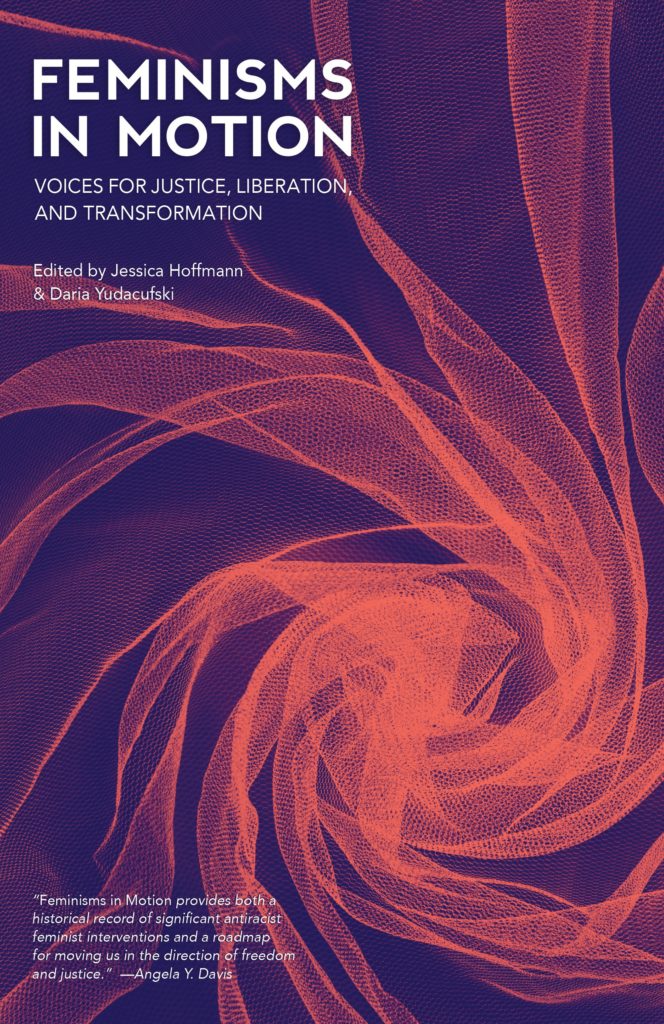
The following interview is an excerpt from the new book Feminisms in Motion: Voices for Justice, Liberation, and Transformation, edited by Jessica Hoffmann and Daria Yudacufski and published this month by AK Press.
In 1972, Silvia Federici participated in founding the Wages for Housework campaign of the International Feminist Collective, which formed chapters in Italy, the United Kingdom, and the United States to demand wages from their respective federal governments for the labor that women do in the home. Born and raised in Italy, she moved to New York in 1967 to study at the State University of New York at Buffalo. Federici has published Caliban and the Witch: Women, the Body, and Primitive Accumulation (2004) and Revolution at Point Zero: Housework, Reproduction, and Feminist Struggle (2012). As an activist, writer, and teacher, she has fought against women’s exploitation, capital punishment, and neoliberal austerity. In January 2015, I spoke to her about the theoretical underpinnings and tactical strategy of the Wages for Housework campaign, how it challenged other movements on the Left, and the importance of making demands that give us more terrain from which to struggle.
RS: What experiences made you want to join the women’s movement?
SF: I’d been very aware throughout my adolescence of all the things I couldn’t do because I was a woman. I grew up in Italy in the postwar period. Fascism had ended, but it had created an intensely patriarchal culture. Women were supposed to produce ten or twenty children for the fatherland. From very early on, I was in revolt against my place as a woman in society.
How did the Wages for Housework campaign develop?
In 1972, in Padua, Italy, there was a meeting between a group of feminists from Italy, including Mariarosa Dalla Costa, and some women from abroad, including Selma James and myself. At this time, the women’s movement was forming and looking for a strategy. The demand of wages for housework was the logical development of the analysis that Mariarosa Dalla Costa had presented in her 1971 article, “Women and the Subversion of Community,” which argued that women’s unpaid domestic work is a central element of capital accumulation because it is the work that produces the workforce. From this analysis stemmed the conclusion that the material basis of sexual discrimination and the unequal sexual division of labor under capitalism is women’s unpaid domestic work.
Wages for Housework was also inspired by struggles in England and the U.S. In 1972, the government in England announced that it would cut the Family Allowance, a source of welfare money that women had been receiving directly from the state, not through their husbands’ paychecks, since the 1940s. The mobilization that formed to resist the cut was important for the formation of the Wages for Housework campaign, as it was clear that this money was a crucial source of autonomy for women. The struggle of mothers on welfare in the United States was also an important factor.
The other component of Wages for Housework was a critique of the New Left and the whole Marxist tradition that both Selma James and Mariarosa Dalla Costa came from. Selma James was married to C. L. R. James [an anticolonial activist, Marxist, and writer] and had lived in Trinidad in the late 1950s during the anticolonial struggle. She had realized that the wage worker is not the only subject of exploitation and revolutionary potential in the capitalist society. There’s a whole other world: the colonial world. If you can see those connections—between the anticolonial struggle and the rise of the women’s movement—then you can make the connection between the unwaged workers of the colonial world and the unwaged workers in the kitchens of the metropolis.
Did you discuss the strategy of fighting for a reform (wages) without intending to create a new, paid job under capitalism but to fight the system as a whole?
Not everyone understood that theoretical perspective, but certainly it was a strategy to change power relations. We rejected the idea that women could acquire autonomy from men only by taking a second job and doing double work. We thought that unless we changed the unwaged nature of our work, we wouldn’t be able to change our lives significantly in any other respect. This was the center of the disease. Even to change the condition of waged work, to change the issue of services—childcare, eldercare—we had to question the nature of unwaged work. Reflecting on the unpaid labor of women was like a window onto the nature of capitalism. I saw that devaluing the reproduction of human life was a central pillar of capitalism, one of the main engines of the accumulation process. So not only was it an entry point to change the situation of women, but also to understand capitalism in a different way.
What was it about the early 1970s that made these movements possible?
It was the Black movement. The civil rights movement gave power to everybody. This was the second time in American history that in the wake of an antislavery movement—because the civil rights movement was also an anti–Jim Crow, anti-apartheid, antislavery movement—a women’s movement began. The Seneca Falls Convention of 1848—the first feminist convention in the U.S.—came at the peak of the abolitionist movement, and it was organized by women who had been involved in the antislavery campaign but found themselves marginalized within it and saw the need to start their own struggle. The same thing happened in the 1970s: it was the civil rights movement that gave women the power to rebel. Women were making connections between these different types of slavery and between racism and sexism. The welfare movement was very much the product of the civil rights movement. Even though Black women were a minority among welfare recipients, they were at the forefront because they were from communities in struggle.

Was Wages for Housework imperative to your life as a single woman without children?
Yes, because I saw Wages for Housework not as payment for specific tasks, but as a broad movement and as a strategy to establish the value of women’s work. It was such a revelatory power even just to name “wages for housework.” It said, these homes are the factories in which we work. It was a question of denaturalizing housework and showing the social, historical character of the work. For example, if you had wages, men could also do that work. We wanted to disconnect it from femininity because the naturalization was a big impediment to struggling against it.
Were you inspired by the Welfare Mothers Movement in the United States? Did you see your campaign as an extension of that struggle?
We were definitely inspired by the Welfare Mothers Movement. They would say things like, “If the government doesn’t think that housework is work because the children are our own, then we’ll swap children!” However, Wages for Housework was not an extension of the welfare rights movement because we had a broader critique of capitalist society and the capitalist organization of work. It started from the perspective of housework, from which we examined and fought against the whole of capitalism.
Did Wages for Housework form alliances with welfare mothers?
We made some connections with women on welfare in 1975–1976. Nationwide, welfare benefits—particularly Aid to Families with Dependent Children—had been under attack since 1973. But starting in 1976 in NYC, benefits were substantially reduced while eligibility criteria were also reviewed. Moving expenses and security deposits on new apartments were cut. Also, women were pressured to reveal the name of their children’s father or have their checks terminated. Women didn’t want to reveal the father because sometimes they didn’t know, and other times they didn’t want anything to do with him and didn’t want him to have rights over their children. In response, we organized a conference and a rally, and for these occasions we distributed flyers and a journal on welfare.
How successful do you feel these campaigns were from today’s vantage point?
We were not successful. Welfare has been practically eliminated and we did not win wages for housework. But we raised consciousness about the fact that housework is real work and it benefits all employers. I think it broadened the women’s movement beyond the whole equality and right-to-work perspectives. We raised the whole issue of exploitation in the home, in connection with welfare, at a crucial time, when the state was criminalizing welfare women, mostly Black women, and portraying them as cheaters and frauds. In the late 1970s in New York, they introduced security guards in welfare offices because women were crying and protesting when they were denied and the cuts were coming down.
Did Wages for Housework clash with mainstream, second-wave feminism?
Wages for Housework did clash with mainstream feminism, and also with the Left. The Left was very hostile to us. At the time, men were very critical of the women’s movement as a whole, accusing it of being divisive. On the Left, they criticized us as economistic, and as a movement that institutionalized women in the home. We had to counter that we had been institutionalized already precisely because of the lack of money. What was most concerning for us was that many feminists thought that the only place women could have power was in the waged workplace. They thought that in the community, there was no power. For us, this was striking because the Black movement was not based in factories, it was based in communities. To imagine that we cannot have any power to fight against capitalism unless we work outside the home and join a union is to accept the bourgeois ideology that the home is not a place of work but a place of personal relations. Some feminists also rejected our analysis because they thought that the home was the only place free from the reach of capitalist relations. They placed capitalism outside the home and saw the latter as a safe haven for the working class.
Like Marx, in your writing you stress the primacy of social relations. Wages mask an underlying relation of exploitation. Can you explain what made Wages for Housework a transformative demand that would disrupt existing social relations between women and men and between women and the state?
I think it was transformative because in the whole leftist, Marxist, anarchist tradition, there was nothing about housework. It was invisible. Even just being able to say “this is work” helped make it possible to fight against it. We thought that Wages for Housework would not be an endpoint, but would contribute to changing social relations in ways favorable to us and our struggle. We believed it would change the relation between women, capital, and the state by putting an end to men’s mediating role. This was not an ordinary wage struggle because it changed the relation between women and men and women and the state by exposing the value of our labor and the immense wealth capital has accumulated out of our unpaid labor. The goal was to get wages for housework in order to raise the level of our struggle, not to end it.
